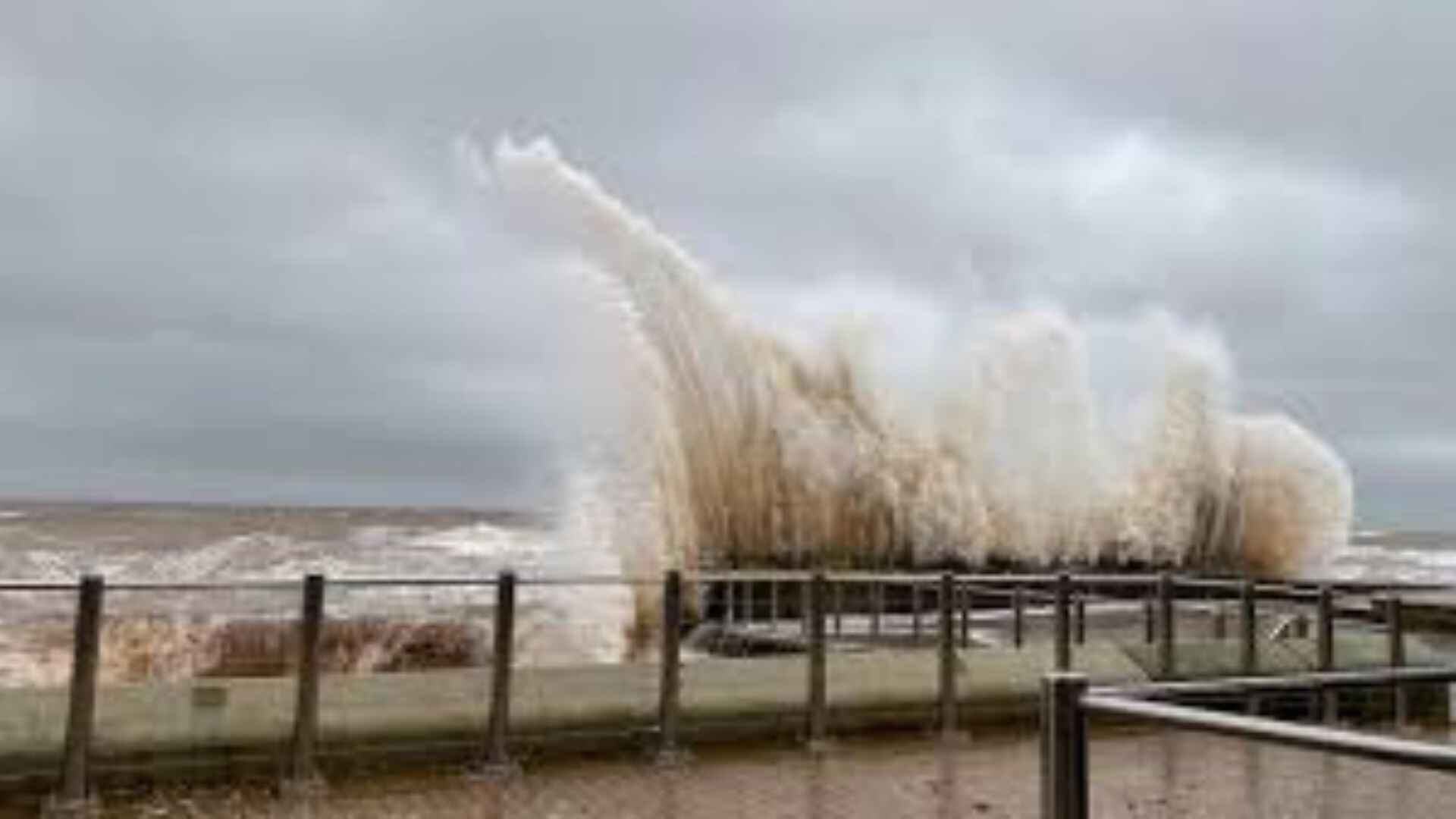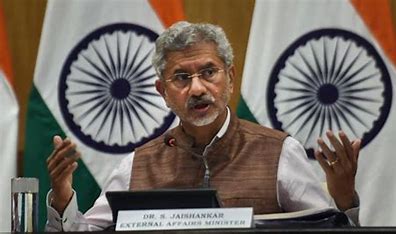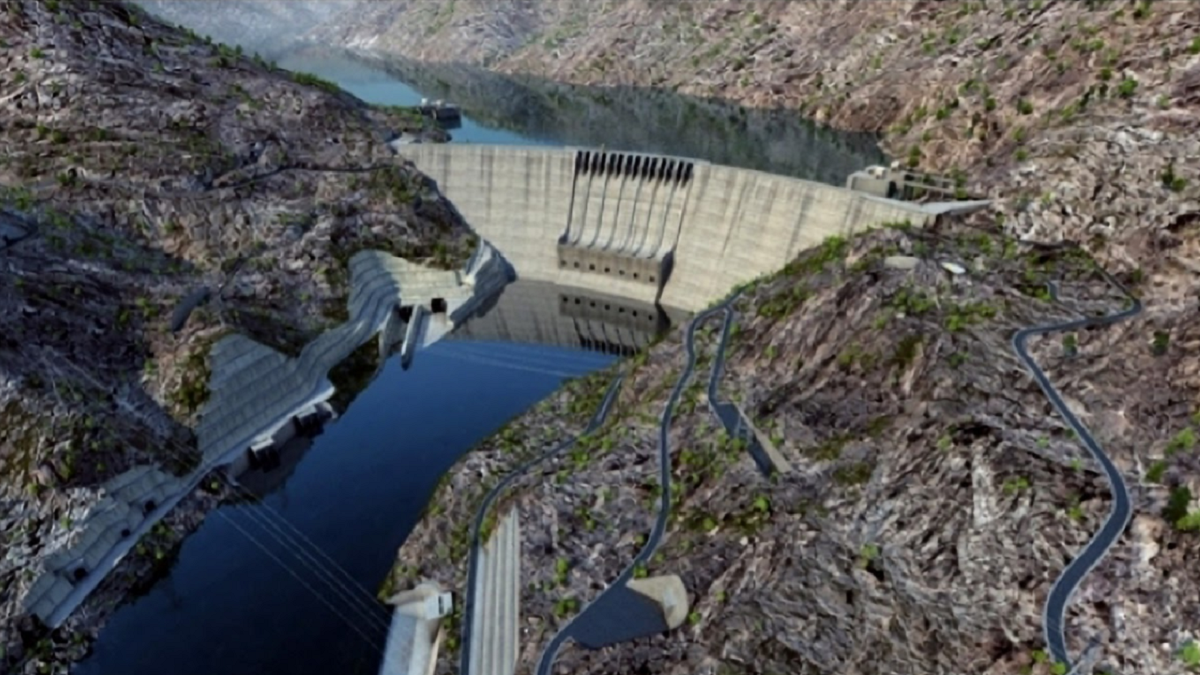
Beggars can’t be choosers. However, they do have a choice of place for begging. Yesterday, Pakistan begged at the US, Saudi and Gulf street corners. Today it is the Chinese, Turkish, and Malaysian street corners. Pakistan can beg for everything, but no one can give it water. Pakistan is going to be a ‘DRY’ frontline geostrategic pivot as it plummets into absolute water scarcity. Under this cloak, Pakistan and China have hastened the deal to build the Diamer Bhasha dam on Indus river in Gilgit Baltistan. It is being touted as Pakistan’s ‘Three Gorges’ to eternally ensure water security. There is nothing farther than the truth. The dam represents Sino-Pak collusion with an unmistakable Chinese Military Civil Fusion stamp. This is not a water scarcity alleviation project but a long-term military plan against India which is the result of China being stymied in Eastern Ladakh.
Pakistan’s Water Problem In the 90s, Pakistan became a water stressed nation. Around 2005, it became water scarce. After 2025, it will enter the absolute water scarcity zone. It will also enter the realm of perpetual failure. The situation is scary. If the economy was dead earlier, the pandemic is burying it. Bailouts/loans/aid do not cater for water. Pakistan’s military spending bloats continually. An impoverished Pakistan is sliding unchecked into absolute water scarcity. This situation will become irrevocable despite the Diamer Bhasha Dam. Pakistan faces an existential crisis from lack of water. Two World Bank Documents Pakistan Country Water Resources Assistance Strategy, Water Economy: Running Dry of 2005 and Pakistan Getting More from Water of 2019 encapsulate Pakistan’s water problems comprehensively.

Pakistan is well endowed with water. In fact, only 16 countries have more water. On the other hand, 32 countries have less water percapita than Pakistan. However, the average per-capita GDP of 26 such countries is 10 times that of Pakistan. Pakistan’s water consumption is dominated by agriculture, which contributes around 1/5th to GDP. The four major crops (wheat, rice, sugarcane, and cotton) consume 80% percent of all water and generate under 5 % of GDP.
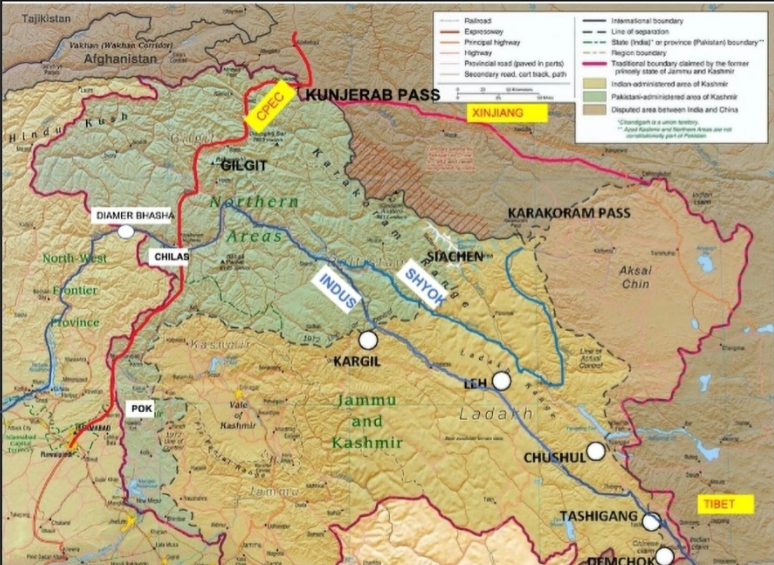
Pakistani Water security has two dimensions — poor water resource management and poor water service delivery (irrigation, drainage, domestic water supply and sanitation). Climate change and global warming, population and economic growth will increase water requirements and variability of availability. Accelerated glacial melting increases flash floods risks in the upper Indus Basin. In the lower Indus Basin, sea level rise and reduced flows of the river due to upstream dams exacerbate seawater intrusion into the delta and coastal groundwater.
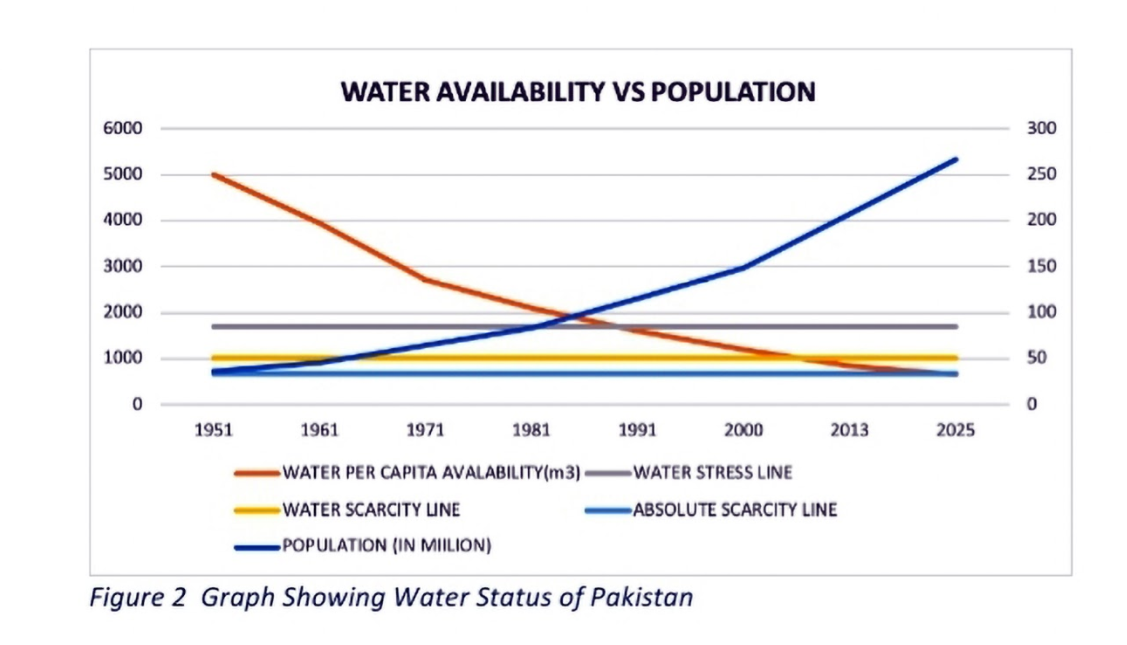
Pakistan’s water problems are multidimensional. Firstly, it is solely dependent on the Indus River — a single source, high risk geographic fate. Secondly, exploding population and depleting water resources. Thirdly, Pakistani water storage capability was barely 30 days in 2005 (much lesser today due to silting). In comparison, the US has 900 days and India has 120-220 days capacity. Fourthly, its two major water reservoirs, Tarbela and Mangla are silted up. Both dip to dead water levels in summer. Fifthly, available water is conveyed at about 40% efficiency only. Sixthly, groundwater is over exploited and depleting alarmingly. Fresh water bodies are shrinking. 70% of underground and lake water is unfit for drinking and harmful for crops. Bacterial, arsenic and other toxic contamination is high. 1/4th of the population may be at risk from arsenic contamination of drinking water. Seventhly, raised embankments in the lower Indus have restricted river meandering. Sedimentation has increased bed levels. Flooding and drainage problems have resulted from this. Eighthly, climate change is causing variability of water flows. This either causes floods or droughts unpredictably. Ninthly, its water infrastructure is poorly maintained and rarely upgraded. Governance deficit is high and project implementation is poor. Tenthly, it is broke. No one pays for water. This was effective since ‘freedom at midnight’ circa 14 Aug 1947. Lastly, by 2025, 50% of Pakistan will be urbanised, where severe water deficiency is the norm. What does the future hold for Pakistan sans water?
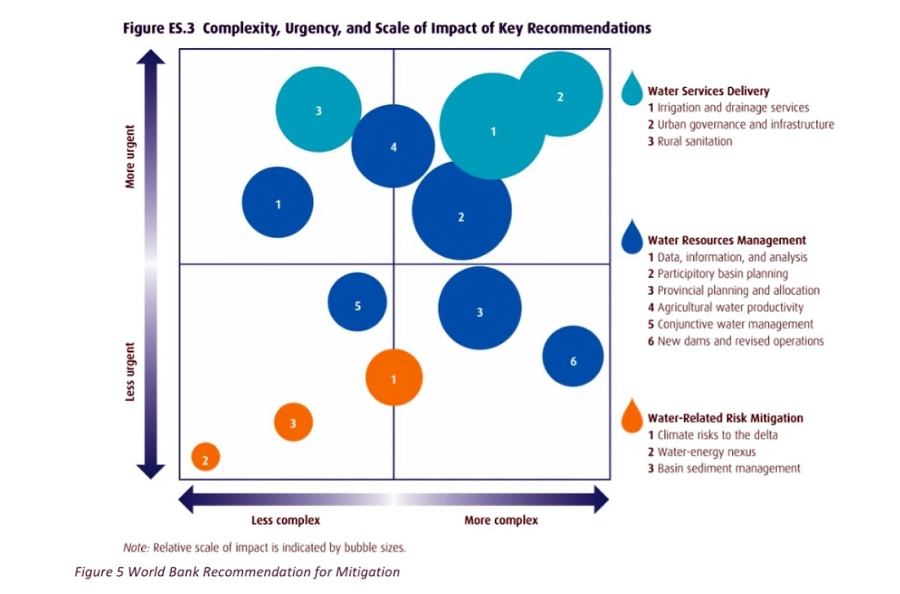
The Diamer Bhasha Dam
Increasing Pakistan’s overground water storage revolves around building two dams. One at Kalabagh, which has greater potential and benefit. The other at Diamer-Bhasha which is complex and risky. The Pakistanis have suddenly opted for the later after four decades.
Diamer Bhasha, a multipurpose mega-dam will be now be built by Chinese on Indus near Chilas. It falls in the Khyber Pakhtunkhwa and Gilgit-Baltistan areas. At a height of 272m, Diamer Bhasha will be the tallest roller compacted concrete dam in the world. The financial outlay was $12-14bn. It will have a power generating capacity of 4.5GW, and water storage capacity of 6.4 million acrefeet of water. The dam only compensates for progressive loss of storage capacity due to silting of older dams at Tarbela and Mangla besides others. Even this will decrease progressively due to sedimentation. Pakistan’s overall storage capacity is likely to remain at 30 days or below only. It was announced on 27 July 2020 that the dam is ready for construction; which is expected to start now and be completed by 2029. 80% of the land for the dam had been acquired earlier.
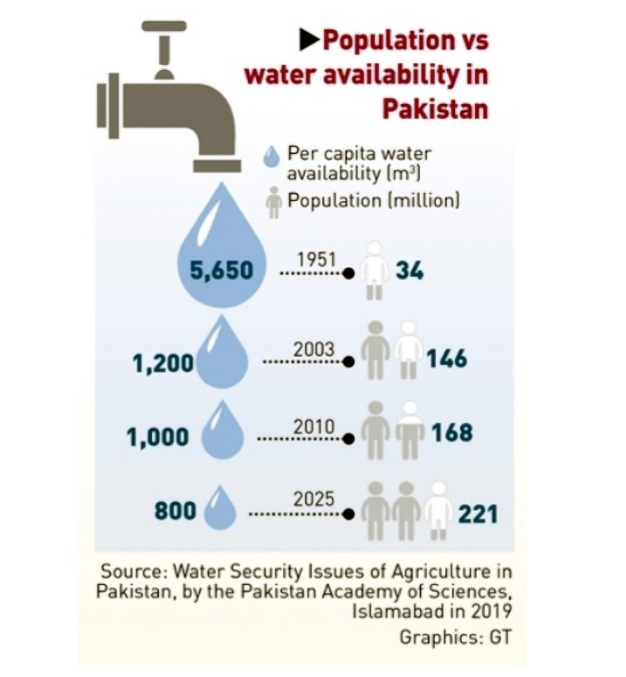
The Diamer Bhasha Dam is controversial. It is located in Indian territory. It is in a high seismic zone and its height is of serious concern. The weight of the large water body in the catchment area could trigger sympathetic tremors during any regional seismic activity. It will have an ecological fallout like unseasonal rains, landslides and floods that might affect the adjacent areas in Pakistan as well as in India. The dam faces local resistance, since it will submerge about 50 villages upstream. More than 35000 people will get displaced and sent to areas afar. There is also a dispute between local tribes over compensation. There is a domestic dispute between Gilgit Baltistan and Khyber Pakhtunkhwa over claims on the royalty from the dam. There is a grouse that Punjab will be the main beneficiary. Residents are also protesting the destruction of historical Buddhist sculptures, inscriptions and petroglyphs in 50 villages, which will be submerged once the dam is operational.
World Bank, Asian Development Bank and other financial institutions consistently refused to finance the dam. They wanted an NOC from India being in disputed territory. Initially this project was part of CPEC. It was withdrawn from the CPEC in 2018, due to China’s strict conditions. Thereafter a crowd funding exercise was started at the behest of a Supreme court judge. That failed. Out of the blue, a joint venture between Power China ( a Chinese state-run firm) and Pakistan’s Frontier Works Organization (a commercial arm of Pakistan’s military) signed the contract for the Dam construction. The contracted sum is $2.75 billion whereas the original outlay was $14 billion. 70% share is Chinese and 30% Pakistani. The details of funding as usual are opaque and fishy.
Analysis
It has been claimed that the dam will alleviate Pakistan’s water scarcity. However, going by the World Bank recommendations (see graphic below), if an equivalent amount is spent in other areas of water services delivery and water resources management which are more urgent and less complex, Pakistan will benefit far more. Any dam is the least urgent and most complex option to mitigate Pakistan’s water woes. Yet Pakistan has opted for this option. It set aside the more beneficial Kalabagh option and has gone in for the risky and complex dam at Diamer Bhasha. Two issues emerge clearly. One, Pakistan’s slide into absolute water scarcity will continue. Two, the Diamer Bhasha Dam is not about Pakistan’s water problem but beyond that.
The newfound acceptance of the Chinese proposal (earlier rejected) and Pakistani Army shepherding the project as a partner clarifies that this is a longterm joint military project and not about water at all. By the first week of June 20 it was clear that (a) Chinese aggressiveness in Eastern Ladakh was stymied (b) an impoverished Pakistan cannot assist China militarily from the West beyond a point. If a credible collusive threat must be posed from the West, Chinese presence and resources must bolster Pakistan. In this context the Dam fits into the design. The haste in starting the project in Jul 20 in the presence of the Paki COAS puts issues into perspective.
The dam is alongside the CPEC main artery. It meets the Pakistani water requirement and enables infrastructure build up simultaneously. Security of investment and personnel justifies Chinese military presence. Diamer Bhasha and Chilas areas give China and Pakistan the ideal base for incremental build-up of force and its application from the West in conjunction with a thrust from Tibet onto Eastern Ladakh. This area enables development of multiple offensive options through Kargil or Western Ladakh. The ultimate idea would be to connect Tibet and POK directly. The CPEC can then follow the easier Indus or Shyok axes rather than the torturous Kunjerab Pass. This was long thought of as a fantasy option. It is no more that. It is a very likely option in the coming decade.
The Indian response must be to modernise its Armed Forces to be able to handle this pincer in a parallel time frame. That is obvious. However a wider perspective is needed. Pakistan’s new map to include J&K and Ladakh as part of its territory and its collusion with China to build a dam in our territory at some level repudiates the Simla Agreement and the Indus Water Treaty. We must therefore commence activities to retake POK as outlined in an earlier article and pursue the water scarcity issue in Pakistan. The tenor of Th Muivah’s, (Chief of NSCN (IM)) recent reiteration of the demand for a separate Naga flag and constitution and the signals emanating from Myanmar and Nepal are clearly indicative of Chinese insidious machinations as again outlined earlier. We also need to take the issue across into Tibet and Xinjiang to dissuade the Chinese from undertaking any misadventure. We must make Pakistan and China look inwards and options for that are many – kinetic and non-kinetic. We need to get our act together.
Lt Gen P.R. Shankar was India’s DG Artillery. He is highly decorated and qualified with vast operational experience. He contributed significantly to the modernisation and indigenisation of Artillery. He is now a Professor in the Aerospace Dept of IIT Madras and is involved in applied research for defence technology. His other articles can be read on his blog www.gunnersshot. com.




